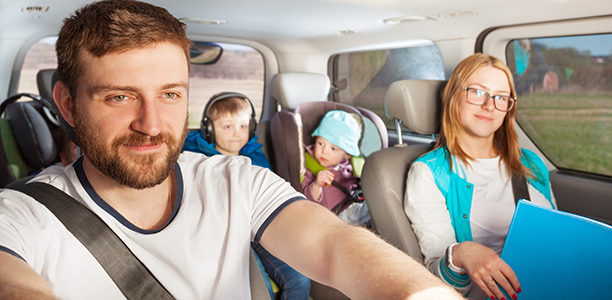Kids are unpredictable, which means driving safely with children can be challenging, and requires preparation. It’s impossible to predict when a child will do something that distracts you while you’re driving. And unlike a ringing phone, you can’t just ignore or “turn off” children who are bickering or complaining in the back seat. So it’s important to take steps to minimise the distractions while you’re driving with kids, and manage distractions safely when they do occur. As the driver of the car you are responsible for any children you drive with, whether they are your own or other people’s children.
Prepare for the drive
Talking to children about driving and how they can help you is an important way for parents and other adults to reduce driving distractions. Whether it’s a long or a short trip, take a few minutes to talk to your children before you set out. Start talking to your children about driving as soon as they are old enough to understand.
Children can’t drive, so it’s impossible for them to know just how much concentration it takes to drive safely. Help them understand by talking to them about it before you start driving. For example, you can say things like, “Driving takes a lot of concentration, and when mum or dad is distracted, it’s easier to have an accident.” Talk about the things that might distract you from driving. For example, let your child know that if they throw something or shout in the car, it will disrupt your concentration.
Take some time to let your children know what sort of behaviour you expect of them while they’re in the car, and agree on some consequences for bad behaviour while you’re driving. For example, you might agree with your children that if they fight while you’re driving the car, they will lose a privilege (such as TV time). If they do misbehave while you are driving, enforce these consequences so that your children learn that driving rules are serious.
Talk to them about the things they might do that may make driving less safe. This is not only things that distract the driver, but also things that put their own safety at risk. For example:
- Trying to open the car door
- Trying to remove their seat belt
- Sticking their head, arms or legs out of an open car window
- Shouting
- Throwing something
Talk to them about the things that they can do to make car travel safe. Talk about why sitting in a child restraint (car seat), putting on a seat belt and leaving it in the correct position are among the most important things they can do to make the drive safer.
Sometimes children will distract the driver without thinking, such as when they drop a toy and ask you to pick it up for them. Before you set out, explain to them why it’s dangerous for you to pick up a dropped toy while you’re driving, and agree that if they do drop something, they’ll need to wait until you stop driving to get it back. If needed, remind them during the drive.
If you’re travelling with a baby, plan short drives to coincide with their nap times, or drive just after feeding them, so that they don’t distract you because they’re hungry or want some playtime. On a long trip, plan to have breaks at intervals when you expect your baby will want to feed. Make sure you pack a nappy change bag when you go out driving with your baby, so that you can easily pull over and change your baby if you need to.
Ask your children to use the toilet before you start driving, especially if you are planning a long drive.
Make sure you’re prepared to concentrate on driving. Get a good night’s sleep and allow plenty of time to reach your destination without speeding or skipping rest breaks.
Make sure the car is safe
Before you start driving with children, make sure you have the correct type of child restraint (car seat or baby capsule) for your child’s age. Check that car seats are properly installed (for example, the child restraint should be in the back seat and secured according to the manufacturer’s recommendation). Place any loose objects in the boot or glovebox, where they will not be a danger if you have to hit the brakes suddenly.
If you will be travelling with a pet, be aware that an animal moving around in the car can be a distraction to the driver. Animals can also be injured or cause injury to your child if you need to slam on the brakes. Invest in a pet harness or travel basket that can fit securely in your car.
Getting ready to go
Ensure your children are properly restrained with a child car seat and/or seat belt. It’s safest (and for young children a legal requirement) to travel with children in the back seat of the car. Activate child safety locks that prevent the back doors being opened from inside the car. If your car has electric windows (or other gadgets that may affect car functioning) that your child could fiddle with while you are driving, lock or deactivate these as well.
Place anything your children might need while you are driving, like drink bottles filled with water, in a place where they can easily reach them without distracting you. If it is a sunny day, place shades over the windows so that your children do not become too hot or get irritated because the sun is in their eyes. Just make sure they are approved shades that don’t block your vision.
When your child is secured in their car seat or seat belt, compliment them for helping you prepare to drive safely. Check that everyone has buckled up just before you leave, and say things like, “Now everyone has buckled up, we’re ready to go.”
Keep children occupied while driving
Bored children are more likely to distract you when driving, so it’s important to do things to keep their minds occupied while you drive. For a short trip, this might be as simple as engaging them in conversation. It’s a good opportunity to remind them that safe driving requires concentration. You could talk to them about all the things you have to do to be a safe driver. Talking about the things you see as you drive, what you will be doing when you arrive at your destination, or how their day was if you are picking them up, are also good topics for driving conversation.
Keeping kids entertained during longer trips is more difficult, but there are plenty of things you can do. If possible, travel with another adult who can interact with children and keep them occupied with games and conversation while you concentrate on driving. Choose soft games or toys that will not hurt them if they fly around during an accident. Avoid toys with firm inflexible parts. Consider keeping some healthy snacks in the car that you can give them if they become hungry. Go for foods that don’t easily spill or make a mess, such as nuts for older children or rusks for a younger child.
Play music that your children love and encourage them to sing along to it, or play an audio book they can listen to. You may be able to borrow audio books to take on long drives from your local library. Play car games that also help your children learn and develop their minds. For example, when you play “I spy with my little eye” or “spelling bee”, your children will increase their knowledge of the alphabet and spelling.
Compliment good behaviour in the car. For example, comment that you like driving with your children when they talk to each other nicely, participate in games to keep themselves busy and don’t try to remove their seatbelt. Comment on their good behaviour several times during a journey. For young children or those that are prone to doing things that distract you (e.g. fiddling with their seatbelt), you might need to promise rewards for good behaviour. You might agree that if they don’t touch their seat belt for the entire trip, you will read their favourite story or play their favourite game when you arrive home. Once they get used to behaving safely in the car, gradually reduce the frequency of rewards. Praise your children if they warn you of driving dangers, such as telling you if their seatbelt comes undone (whether by accident because they were playing with it, or it wasn’t buckled properly to begin with) or the door is not closed properly. Then safely park the car and fix the problem.
If your children do misbehave, stay calm and remind them that what they are doing is distracting you from driving safely. Being frustrated or emotional will only distract you from driving even more, so have strategies to calm yourself down, like taking deep breaths as you drive. Remember that it’s often okay to ignore children’s misbehaviour in the car. If you’re getting frustrated at children bickering, but if they are not doing anything that presents a danger to themselves or anyone else in the car, take a deep breath and keep your mind on the road. If you need to talk to them, stay composed and use a calm voice.
Take care of children’s special needs
Children with special needs may require particular things to help them stay calm on the road. For example children on the autism spectrum who experience sensory difficulties may benefit from wearing headphones or earplugs while driving. This will help block out loud sounds that occur during the drive, such as sirens or particularly noisy traffic. Talking to children about the sounds they hear may also help them cope with the unusual sounds they come across while driving.
Children with sensory issues may also be bothered by the feel of a seat belt or safety harness. They will probably find it easier to sit buckled in if you dress them in clothes that prevent the belt or harness touching their skin.
Take regular breaks during long trips
If children are misbehaving and you need to intervene, pull over to the side of the road and take a break from driving. You might simply need to tell your children that you will wait by the side of the road until they stop doing whatever it is they are doing that distracts you and makes your driving unsafe. Emphasise that you can’t keep driving while they are fighting or misbehaving because it is unsafe, and remind them of the driving rules you agreed on.
Be aware that your children are more likely to do something to distract you if they are bored or hungry, so take regular breaks during a long drive. If children are complaining that they need to wee or asking, “Are we there yet?” it’s probably a good time to take a break.
Make sure you stop in a safe spot where you will not present a danger to other vehicles, and preferably where your children do not need to get close to the road. Many major country roads around Australia have designated roadside stopping places or rest areas where vehicles may stop safely. Some of these have additional facilities such as rubbish bins or public toilets.
Use breaks to relax your mind from driving, and to give children a chance to expend the energy they have built up sitting in the car. If it’s time for a meal, have something to eat. If not, drink some water or have a healthy snack. Then spend some time being physical. Plan to stop regularly at places where there is a park with equipment your children can play on, or a space for them to run around safely. If you have a baby, travel with a picnic rug that you can spread out for them to roll around on during driving breaks. Ensure your children stay away from the road and keep an eye out for other cars entering or leaving the parking area.
Arriving safely at your destination
When you arrive at your destination, help your child leave the car from the kerbside door (if you are parked on the street) so they won’t need to step out onto the road. Remind young children to wait for you to help them unbuckle their seat belt once you have stopped, so they get used to the idea of only unbuckling their belt when you’re there. Never leave your children alone in the car.
References
- Children’s Hospital Colorado. Driving safely when your kids are misbehaving. 2016 (cited 11 June 2017). Available from: [URL link]
- Royal Society for the prevention of Accidents. Duty of care. 2017 (cited 8 July 2017). Available from: [URL link]
- Raising Children Network. Child car safety. 2017 (cited 11 June 2017). Available from: [URL link]
- Queensland Government. School road safety for kids: Parents booklet. 2011 (cited 11 June 2017). Available from: [URL link]
- Transport Accident Commission Victoria. Holidays and road trips. 2015 (cited 11 June 2017). Available from: [URL link]
- Queensland Government. Choosing a child restraint. 2010 (cited 30 July 2015). Available from: [URL link]
- Tasmanian Government. Child restraints: A guide to car seats. 2015. (cited 30 July 2017). Available from: [URL link]
- Kentucky Office of Highway Safety. Distracted driving. 2015 (cited 8 July 2017). Available from: [URL link]
- Queensland Government. Road rules: Child restraints. 2017 (cited 13 July 2017). Available from: [URL link]
- Road Driver. On the road with children. 2017 (cited 8 July 2017). Available from: [URL link]
- Raising Children Network. Travelling with children by car, plane, bus or train. 2016 (cited 11 June 2017). Available from: [URL link]
- Transport for NSW. Children: Passenger Safety. 2015 (cited 11 June 2017). Available from: [URL link]
- Neuroscience Research Australia and Kidsafe Australia. Best practice guideline for the safe restraint of children travelling in motor vehicles. 2013 (cited 11 June 2017). Available from: [URL link]
- Indiana University School of Medicine. Car safety for your child with autism. 2013 (cited 8 July 2017). Available from: [URL link]
- Schlossler A. Ten strategies for travelling with children with autism. Autism Speaks; 2009 (cited 8 July 2017). Available from: [URL link]
- Main Roads Western Australia. Rest areas. 2016 (cited 4 July 2017). Available from: [URL link]



 (6 votes, average: 4.33 out of 5)
(6 votes, average: 4.33 out of 5) 






